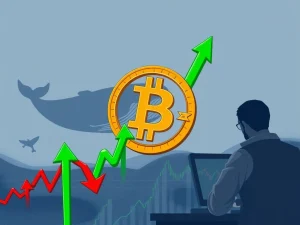Bitcoin Supply Shock: Is a Massive Squeeze Coming as Exchange Supply Hits 7-Year Lows?

Are we on the verge of a significant shift in the Bitcoin market? Recent data suggests a potential Bitcoin supply shock is brewing. The amount of Bitcoin held on centralized exchanges has plummeted to levels not seen since 2018. This dramatic decrease signals that fewer coins are readily available for trading, a factor that could have profound implications for Bitcoin’s price dynamics, especially as demand potentially increases.
Why is Bitcoin on Exchanges Dropping So Low?
The percentage of total Bitcoin supply held on exchanges has fallen below 11% for the first time since March 2018. This is a significant drop from the peak of over 17.2% observed in March 2020. Since that peak, roughly 1.26 million BTC, or over 6% of the total supply, has been moved off exchanges. Several key factors are driving this trend:
- Increased HODLing: More investors are moving their Bitcoin into cold storage for long-term holding.
- Institutional Adoption: Large financial institutions prefer private custody solutions over public exchanges.
- Post-FTX Trust Issues: The collapse of FTX eroded trust in centralized platforms, pushing users towards self-custody.
Understanding these drivers is crucial to grasping the potential impact of dwindling Bitcoin on exchanges.
Bitcoin HODLing Reaches Multi-Year Highs
Data from CryptoQuant highlights that Bitcoin investors are demonstrating strong conviction, holding onto their coins at levels not seen in over two years. The Exchange Flows to Network Activity Ratio, which tracks the volume of BTC flowing to exchanges relative to overall on-chain activity, has dropped significantly. A low ratio indicates that despite price movements, fewer Bitcoins are being deposited onto exchanges, suggesting investors are holding rather than preparing to sell.
Historically, such low readings have corresponded with periods where long-term holders are accumulating or simply keeping their assets off exchanges. This strong preference for cold storage directly reduces the available supply for active trading, reinforcing the narrative of a potential Bitcoin HODLing phase driving scarcity.
Institutional Bitcoin Demand Fuels Outflows
A major catalyst for the decrease in Bitcoin on exchanges is the accelerating pace of institutional adoption. Large players like BlackRock, Fidelity, and Franklin Templeton are increasingly allocating capital to Bitcoin, but they typically use specialized third-party custody services rather than holding large amounts directly on public trading platforms. Coinbase Prime, for instance, reported over $212 billion in assets under custody in Q1 2025, driven by institutional inflows, while the main Coinbase exchange saw significant BTC outflows.
The introduction and success of spot Bitcoin ETFs have played a pivotal role here. These investment vehicles have attracted billions of dollars, and the underlying Bitcoin is held by custodians, not on public exchanges. As of early June 2025, spot Bitcoin ETFs managed $44.54 billion in assets, a massive increase since their launch. Surveys also indicate a strong intent among institutional investors to increase their crypto exposure, further solidifying the trend of Institutional Bitcoin moving off exchanges and into dedicated custody solutions.
The Lingering Impact of the FTX Collapse on Bitcoin on Exchanges
The dramatic collapse of the FTX exchange in late 2022 triggered a significant shift in investor behavior. Following the event, Bitcoin saw sustained net outflows from exchanges throughout early to mid-2023. This period marked one of the largest withdrawal events in Bitcoin’s history, with hundreds of thousands of BTC leaving centralized platforms.
This surge in withdrawals underscores a decline in trust towards centralized exchanges since the FTX incident. Many users opted for self-custody solutions or alternative platforms perceived as more secure. This trust deficit continues to contribute to the overall decrease in Bitcoin on exchanges, as investors prioritize control and security over easy access for trading.
Conclusion: What Does a Bitcoin Supply Shock Mean?
The confluence of factors – increasing Bitcoin HODLing, accelerating Institutional Bitcoin adoption via custody and Bitcoin ETFs, and persistent trust issues post-FTX – has driven the percentage of Bitcoin on exchanges down to levels not seen in seven years. With over 1.2 million BTC withdrawn from exchanges since 2020, the available supply for trading is becoming increasingly scarce.
This situation creates the potential for a significant Bitcoin supply shock. If demand remains strong or increases while the readily available supply continues to shrink, it could exert substantial upward pressure on Bitcoin’s price. While this article provides analysis based on current data, it is not investment advice. Readers should always conduct their own research before making any investment decisions in the volatile cryptocurrency market.









